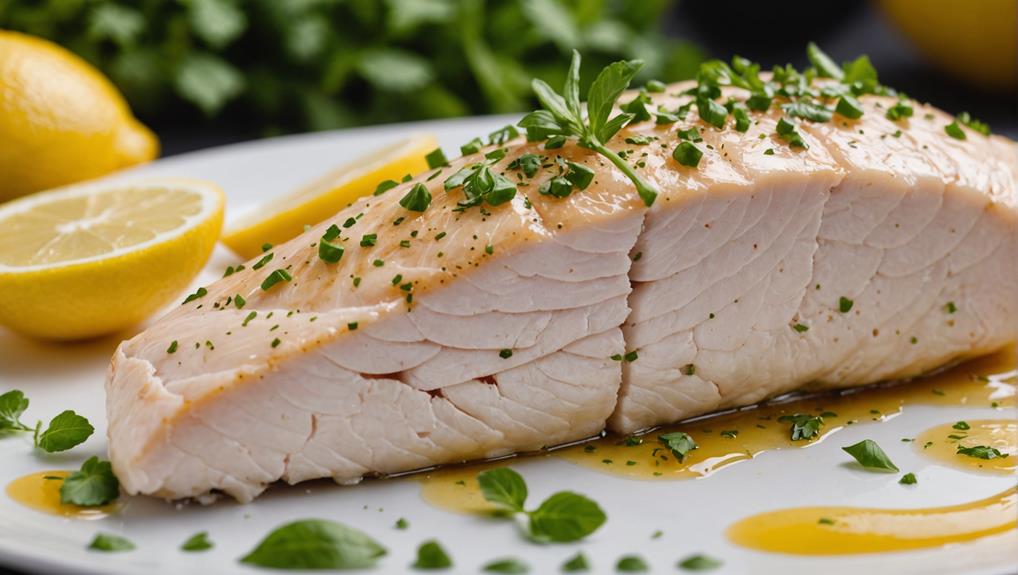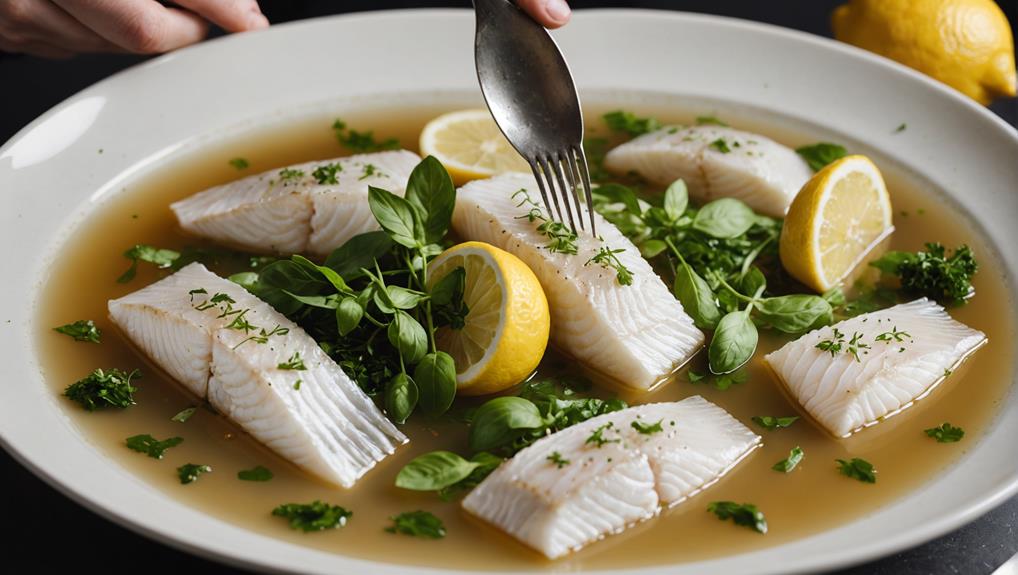To achieve perfect poached chicken, maintain water temperature between 170°F and 180°F. Start with cold water or broth, ensuring chicken is fully submerged. Add salt and aromatics for flavor. Use a thermometer to monitor both water and chicken temperatures, aiming for an internal chicken temperature of 165°F for safety. Cook boneless, skinless breasts for 10-15 minutes, adjusting for thickness. Avoid boiling, as it toughens the meat. After cooking, let the chicken rest for 5 minutes to redistribute juices. This gentle cooking method preserves moisture and tenderness, resulting in succulent poached chicken. Mastering these temperature secrets will elevate your culinary skills to new heights.
Understanding the Poaching Process
Poaching is a gentle cooking method that’s perfect for creating tender, juicy chicken. This moist-heat cooking method involves submerging chicken in liquid and maintaining a precise temperature between 170°F and 180°F.
Unlike boiling, which can toughen meat, poaching allows for slow, even cooking that preserves moisture and tenderness.
To master this technique, start with cold water and gradually bring it to a simmer. This ensures even cooking throughout the chicken pieces. The poaching process typically takes 10-20 minutes, depending on the thickness of the chicken.
You’ll know it’s fully cooked when the internal temperature reaches 165°F.
Elevate your poached chicken by using flavored poaching liquids like broth or adding aromatics such as garlic, herbs, and spices. This infuses the meat with delicious flavors as it cooks.
Remember, the key to perfect poached chicken lies in temperature control. Keep the liquid at a gentle simmer, never allowing it to boil.
Ideal Equipment for Temperature Control
To achieve perfectly poached chicken, you’ll need the right equipment for precise temperature control. An instant-read thermometer is your secret weapon, ensuring your chicken reaches the safe internal temperature of 165°F.
For even more precision, consider investing in a digital probe thermometer, which allows you to monitor the temperature throughout the poaching process without lifting the lid and losing heat.
When it comes to cookware, opt for a large saucepan with a lid to maintain consistent heat retention. A shallow pan can be a game-changer, promoting even cooking and better temperature distribution compared to deeper pots.
For optimal results, choose a heavy-bottom pot that distributes heat evenly, eliminating hot spots that can lead to unevenly cooked chicken.
Preparing Chicken for Poaching
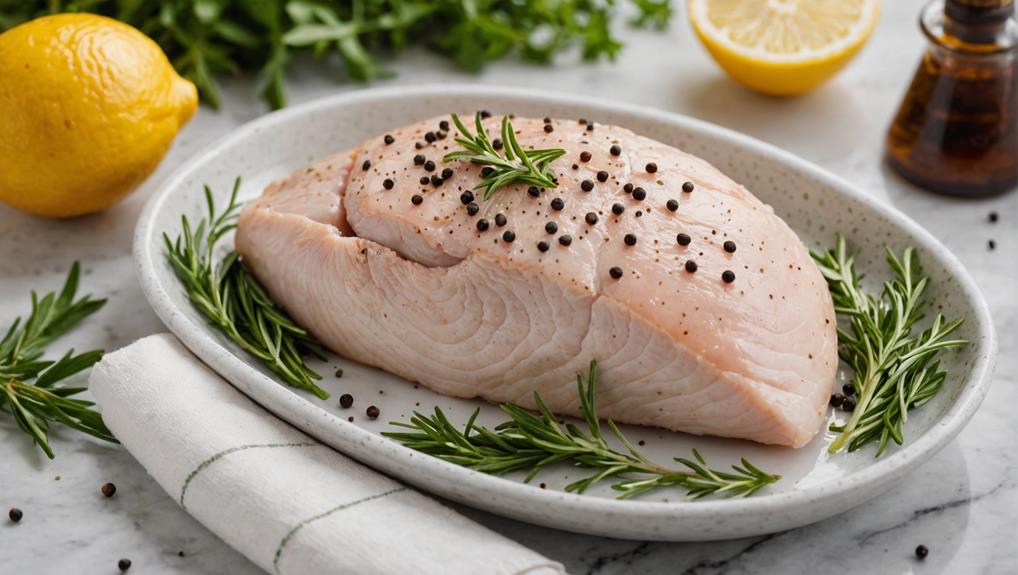
Proper preparation is crucial for achieving perfectly poached chicken. Start with two large, skinless, boneless chicken breasts, weighing about 1 lb. 4 oz. total. This ensures even cooking throughout the meat, resulting in tender, juicy poached chicken.
Fill a pot with 4 cups of cold water or broth, making sure it covers the chicken by at least an inch. It’s essential to begin with cold liquid, as this promotes even cooking and prevents the chicken from becoming rubbery.
Arrange the breasts in a single layer to allow uniform heat exposure during poaching.
Now, it’s time to elevate your poached chicken’s flavor profile. Add 3 tablespoons of kosher salt to the water for seasoning.
For an innovative twist, experiment with aromatics like garlic cloves, bay leaves, and fresh herbs. These additions infuse the chicken with complex flavors as it cooks.
Setting the Perfect Water Temperature
To achieve perfectly poached chicken, you’ll need to set the water temperature just right. Aim for a range between 170°F and 180°F, which will keep your chicken tender and juicy without overcooking.
You’ll want to avoid boiling the water, as temperatures above 200°F can result in tough, rubbery meat, so maintain a gentle simmer throughout the cooking process.
Ideal Temperature Range
Achieving the perfect poached chicken starts with setting the right water temperature. To master this culinary technique, you’ll need to maintain an ideal temperature range of 170°F to 180°F. This gentle cooking method ensures your chicken remains tender and juicy, avoiding the dreaded rubbery texture that comes from overheating.
Here’s what you need to know about the ideal temperature range for poaching chicken:
- Start with cold water to promote steady heating
- Aim for a low simmer, never allowing the water to boil
- Monitor the temperature closely, keeping it below 180°F
- Use a meat thermometer to check for an internal temperature of 165°F
- Adjust heat as needed to maintain the optimal range
Avoiding Boiling Point
Consistently maintaining the right water temperature is crucial when poaching chicken. To achieve tender poached chicken, you’ll want to keep the water between 170°F and 180°F, well below the boiling point. This gentle cooking method ensures your chicken remains moist and flavorful.
Start by adding cold water to cover your chicken in the pot. Using cold water prevents the meat from cooking too quickly, which can lead to toughness. As you heat the poaching liquid, aim for a low simmer rather than a rolling boil. Boiling can cause moisture loss and result in dry, overcooked chicken.
To maintain the ideal temperature, use medium heat and monitor closely. An instant-read thermometer is your best friend here; check for doneness by ensuring the internal temperature reaches 165°F.
Maintaining Gentle Simmer
The art of maintaining a gentle simmer is crucial for perfectly poached chicken. You’ll want to keep the water temperature between 170°F and 180°F to ensure your poached chicken breasts come out tender and juicy.
Start with cold water and gradually heat it, allowing for even cooking throughout the meat. As you monitor the heat, look for these signs of a gentle simmer:
- Small bubbles rising slowly to the surface
- No vigorous boiling or rolling water
- Steam rising gently from the pot
- Chicken moving slightly in the water
- Thermometer reading within the ideal range
Adjust the heat as needed to maintain this low, controlled temperature. You’ll notice the difference in texture when you’ve mastered the gentle simmer technique.
Use an instant-read thermometer to check the internal temperature of your chicken, aiming for 165°F. Remember, overcooked chicken becomes tough and rubbery, so it’s essential to remove it from the heat at the right moment.
After cooking, let your poached chicken rest for a few minutes to redistribute the juices, resulting in a perfectly cooked, moist, and flavorful dish.
Maintaining Consistent Gentle Heat
To maintain consistent gentle heat for perfectly poached chicken, you’ll want to keep the water temperature between 170°F and 180°F.
This optimal range allows for gentle, even cooking that won’t toughen the meat, ensuring your chicken remains tender and juicy.
Remember to use medium heat to achieve a low simmer rather than a rapid boil, as high temperatures can lead to dry, rubbery chicken.
Optimal Temperature Range
Mastering the optimal temperature range is crucial for perfectly poached chicken. You’ll want to keep your cooking process within 170°F to 180°F for juicy results that aren’t overcooked.
Just as with preparing a delicious Harvest Vegetable Soup, starting with cold water ensures even heating throughout the chicken, preventing tough or rubbery texture.
Maintain a gentle simmer rather than a boil to preserve moisture and tenderness. An instant-read thermometer is your best friend here, helping you achieve the ideal internal temperature of 165°F in the thickest part of the chicken.
Remember, precision is key to innovation in the kitchen.
Here’s what you need to keep in mind:
- Use cold water to start the poaching process
- Aim for a temperature range of 170°F to 180°F
- Maintain a gentle simmer, not a boil
- Check internal temperature with an instant-read thermometer
- Let the chicken rest for 5 minutes after poaching
Low-and-Slow Cooking Technique
Patience is key when it comes to the low-and-slow cooking technique for poached chicken. You’ll want to maintain a consistent gentle simmer throughout the process, avoiding a rolling boil that can lead to moisture loss.
Start by placing your boneless chicken breasts in cold water, allowing for gradual heating and uniform cooking. As the cooking liquid reaches a simmer, reduce the heat to keep the temperature between 170°F and 180°F.
This low-and-slow cooking method ensures your poached chicken breast remains tender and juicy. Keep a close eye on the internal temperature using an instant-read thermometer, aiming for 165°F for optimal doneness and safety.
Remember, the key to perfectly poached chicken lies in preserving its moisture content. By maintaining a gentle simmer, you’re allowing the chicken to slowly absorb flavors from the cooking liquid and any aromatics you’ve added.
This technique not only results in evenly cooked meat but also prevents the risk of rubbery texture often associated with high-heat cooking. Embrace this innovative approach to poaching, and you’ll unlock the secret to consistently delicious, tender chicken breasts.
Monitoring Protein Structure Changes
The science behind perfectly poached chicken lies in understanding protein structure changes. As you monitor the temperature of your poached chicken, you’re actually observing a fascinating transformation at the molecular level.
The proteins in the meat begin to denature at around 140°F, initiating changes that affect both tenderness and moisture retention.
To achieve optimal results, keep these key points in mind:
- Protein denaturation starts at 140°F (60°C)
- Muscle fibers tighten and expel moisture at 160°F (71°C)
- The ideal internal temperature is 165°F (74°C)
- Monitor the thickest part of the chicken closely
- Remove chicken immediately upon reaching 165°F
Ensuring Food Safety Standards
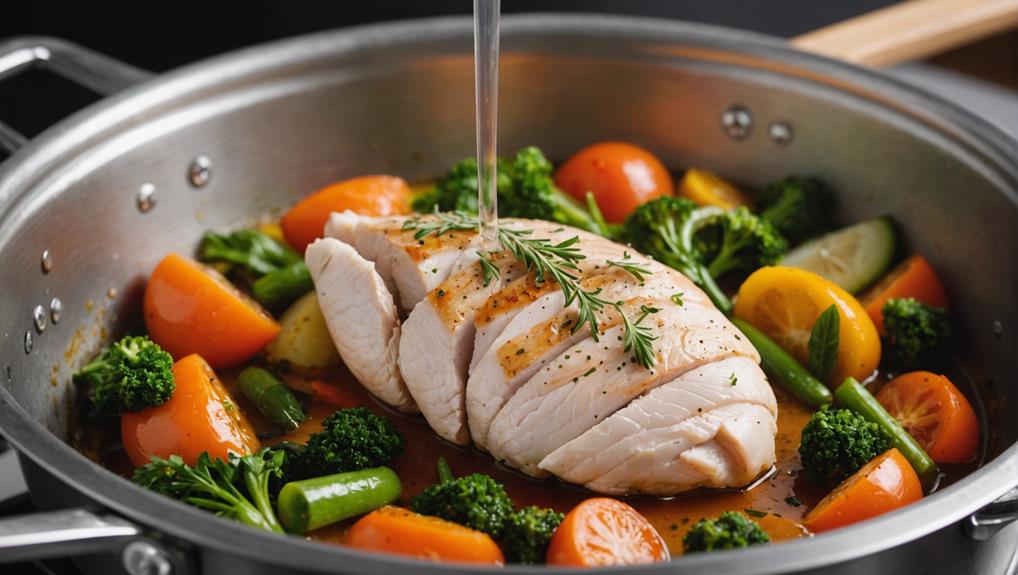
Consistently ensuring food safety standards is crucial when poaching chicken. To master this culinary technique while safeguarding your health, you’ll need to focus on key temperature controls. Your poached chicken must reach an internal temperature of 165°F, the safe zone for preventing foodborne illnesses. Equip yourself with an instant-read meat thermometer, your most reliable ally in this quest for food safety. Always check the thickest part of the chicken for an accurate reading.
Innovation in your poaching process starts with cold water, promoting even cooking and minimizing bacterial survival risks.
Once you’ve crafted your perfectly poached chicken, don’t let your efforts go to waste. Refrigerate any leftovers in an airtight container within two hours of cooking, and consume them within 3-4 days for optimal safety.
If you’re planning ahead, freezing is an excellent option. Cool and drain your cooked chicken, then store it in a freezer-safe container for up to 3 months. This approach prevents bacterial growth and maintains the quality of your culinary creation.
Achieving Tender Texture Through Timing
Mastering the art of tender poached chicken boils down to precise timing and temperature control.
You’ll want to maintain a gentle simmer, keeping the water between 170°F and 180°F. This temperature range is crucial for achieving that perfect, moist texture you’re after.
To ensure your poached chicken reaches optimal doneness without overcooking, consider these key points:
- Cook skinless, boneless chicken breasts for 10-15 minutes, adjusting for thickness
- Use an instant-read thermometer to check for an internal temperature of 165°F
- Remove chicken promptly once it reaches the target temperature
- Allow the chicken to rest for 5 minutes after poaching
- Monitor cooking time closely to prevent dry, rubbery results
Enhancing Flavor During Poaching
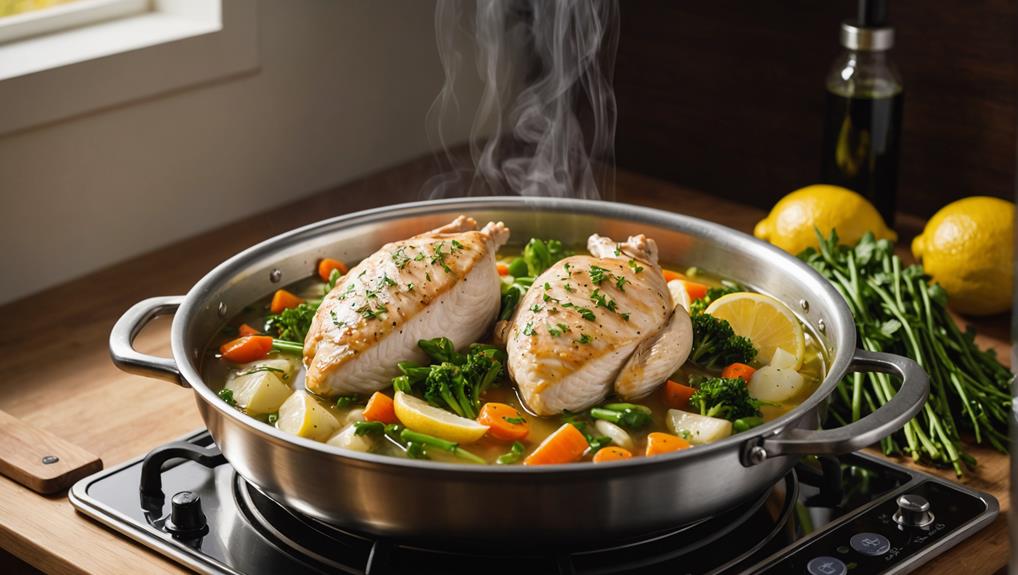
Numerous techniques can elevate your poached chicken from bland to flavorful. Start by generously salting your poaching liquid with about 3 tablespoons of Diamond Crystal kosher salt. This ensures your chicken is well-seasoned throughout.
Next, infuse your liquid with aromatics like garlic, bay leaves, and fresh herbs such as thyme and parsley. These ingredients will add depth and complexity to your dish.
For an extra layer of richness, consider using chicken stock, vegetable broth, or a blend of water and white wine as your poaching liquid. These alternatives impart additional flavor during the cooking process.
To introduce subtle heat and brightness, add whole peppercorns, dried chilies, or fresh lemon slices to the mix.
Frequently Asked Questions
What Is the Best Temperature to Poach Chicken?
You’ll want to poach your chicken between 170°F and 180°F. This temperature range ensures food safety while maximizing meat tenderness. Experiment with various poaching liquids and marinades for flavor infusion. Don’t forget to monitor cooking time closely.
Should I Add Salt When Poaching Chicken?
You’ve heard salt’s essential, but is it? Absolutely! Salt benefits go beyond flavor, enhancing poaching techniques. It’s key for flavor absorption and texture changes. Experiment with salt quantities and seasoning alternatives to elevate your chicken’s taste and juiciness.
How Do You Flavour Chicken When Poaching?
You’ll create a flavor-packed infusion by adding herbs, citrus zest, garlic cloves, and onion slices. Don’t forget bay leaves and your choice of peppercorns. Elevate the poaching liquid with vegetable stock, a splash of wine, or soy sauce for depth.
Why Is My Poached Chicken Breast Tough?
Like Icarus flying too close to the sun, you’ve likely overcooked your chicken. Your cooking technique, water temperature, and poaching time are crucial. Consider brining for enhanced meat tenderness. Don’t forget the resting period for optimal results.
Final Thoughts
You’ve now unlocked the secrets to poaching chicken perfectly. By mastering temperature control, you’ll create the juiciest, most tender chicken imaginable. Remember to maintain consistent, gentle heat and monitor protein changes closely. Always adhere to food safety standards, timing your poach for optimal texture. With these techniques, you’ll elevate your culinary skills to new heights, impressing even the most discerning palates. Keep practicing, and soon you’ll be poaching chicken like a seasoned pro.

